
Posts Tagged "Stress"
Communicating in Times of Crisis
Even when money is tight and the future is uncertain, remember to keep making deposits to your emotional bank account.
We are all living in highly stressful times; I hope this message finds you well.
Now that so many of us are working remotely, we are finding communication much more challenging. Even with video conferencing tools, it is still difficult to observe and process all of the nonverbal cues that we used to depend on for communication with coworkers, customers, and vendors.
Some of you that are working from home are fortunate to have your family with you. But by now you know that the additional job titles of teacher, cook, entertainer, etc., come with their stress-inducing challenges.
What to do?
First:
Breathe. Nice long relaxing breaths…
What we know about DISC in our own personality can help us, and those we care about, through the new abnormal.
When stress is present, people seek to reduce it, often by dumping it on the person “responsible” for the tension, which is unproductive. Each personality style has its own characteristic manner of “dumping” stress on another.
We all have stress-inducing situations that come and go in our lives. Lately, for most of us, the stress has been sticking around a lot longer. In crisis situations stress is amplified. Behavioral expressions can change, and behaviors may intensify. We need to be ever more vigilant in our interactions with those we care about and those who are dependent on us in our work and at home. This is not easy. Even people with highly developed emotional intelligence (EIQ) are struggling.
Emotional intelligence refers to the capacity to be aware of, control and express our emotions as well as understanding the emotions of others. Empathy is an important characteristic of high EIQ but can be very difficult to display when we are stressed and outside of our comfort zone. Identifying and addressing the characteristic fears of our personality type will help to avoid some of the rough spots. Those rough spots can drain your emotional bank account and reduce your EIQ.
The chart below shows how a reduced EIQ can negatively impact personality traits:
DISC + EMOTIONAL INTELLIGENCE
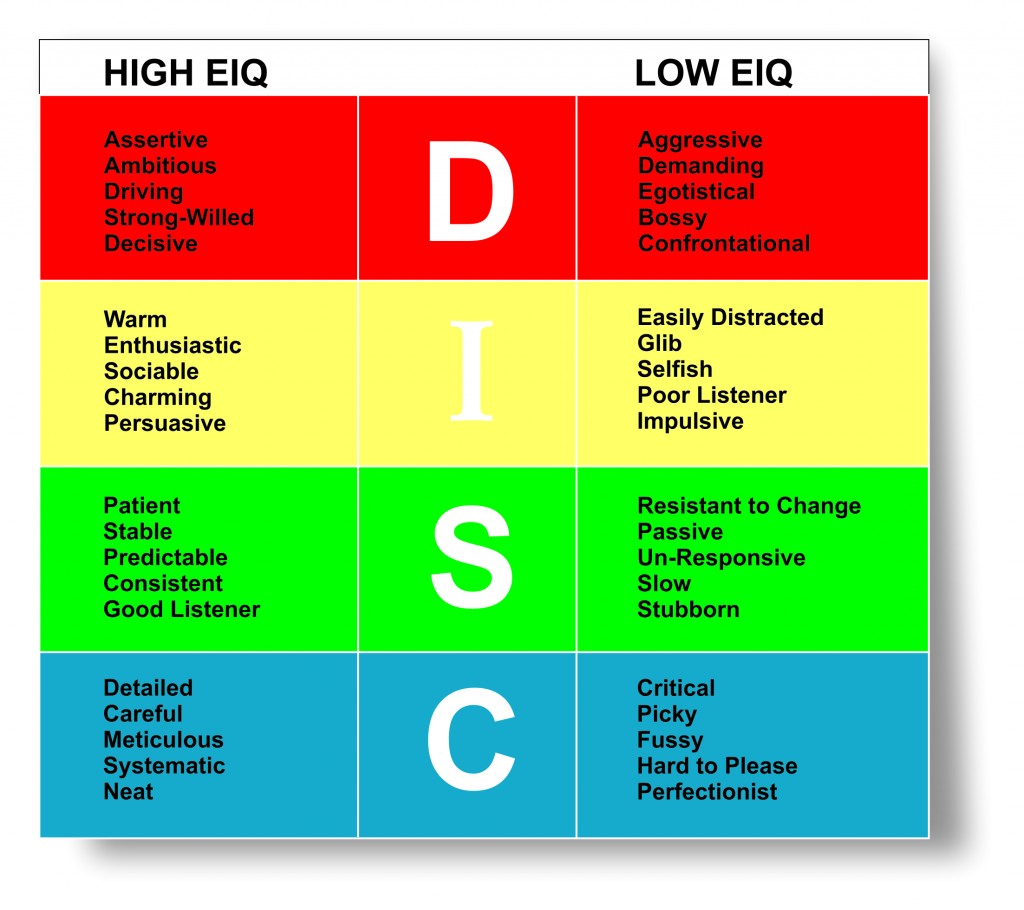
If you found yourself migrating toward the right side of the chart recently, you are not alone. Without being conscious of the change:
- A decisive and ambitious person can become more aggressive and confrontational when things are out of control.
- A normally sociable and charming individual can become glib and distracted without enough opportunity for social interactions.
- A patient, stable person can become stubborn or even un-responsive when there is no system or the normal pace of their life is disrupted.
- A careful, neat person can become very critical and fussy when new rules or restrictions are unclear or not universally adhered to.
The good news is that you can adapt back to more positive traits. Identify the cause of the stress, based on your personality type, and address it.
Take some time to review your Team Strength DISC profile. If you do not have a profile, then take a look at the graphic below with some broad descriptors of each of the DISC personality types. Find the broad descriptor that matches your personality best, keeping in mind that there may be two different areas that apply, and use that as your guide.
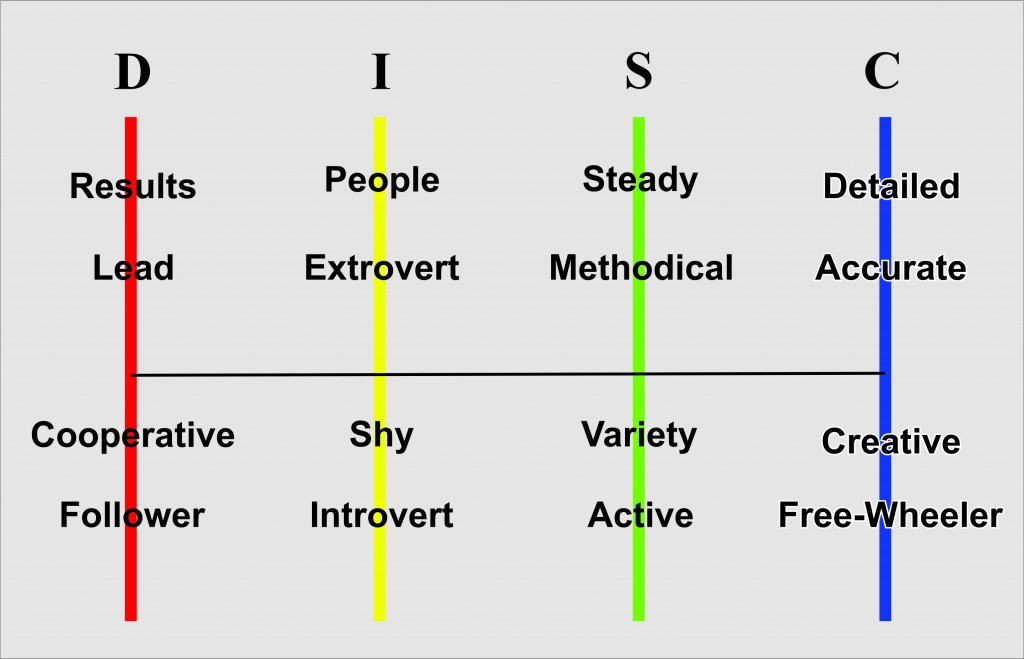
Your Team Strength DISC profile will describe in detail your personality type and highlight some of the drivers that you react to, what you need and also some of the fears that can affect you. The chart below summarizes three key areas in each of the four profile styles.
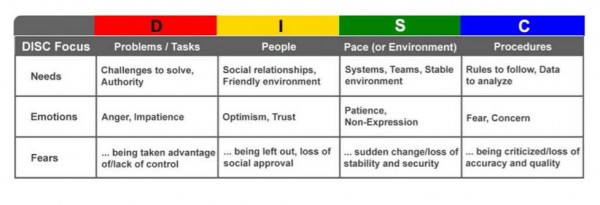
The following charts summarize the behaviors and needs of each style.
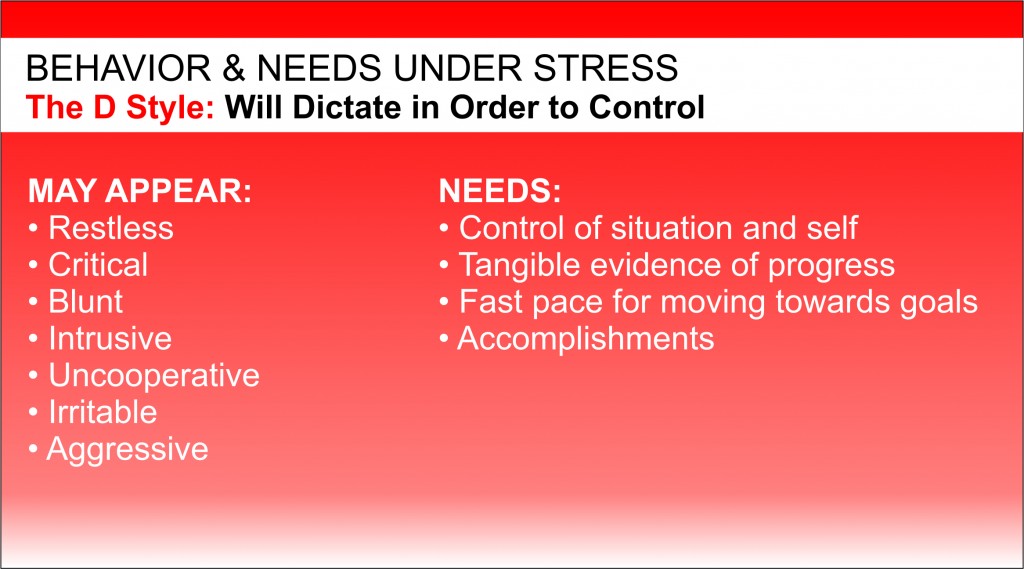
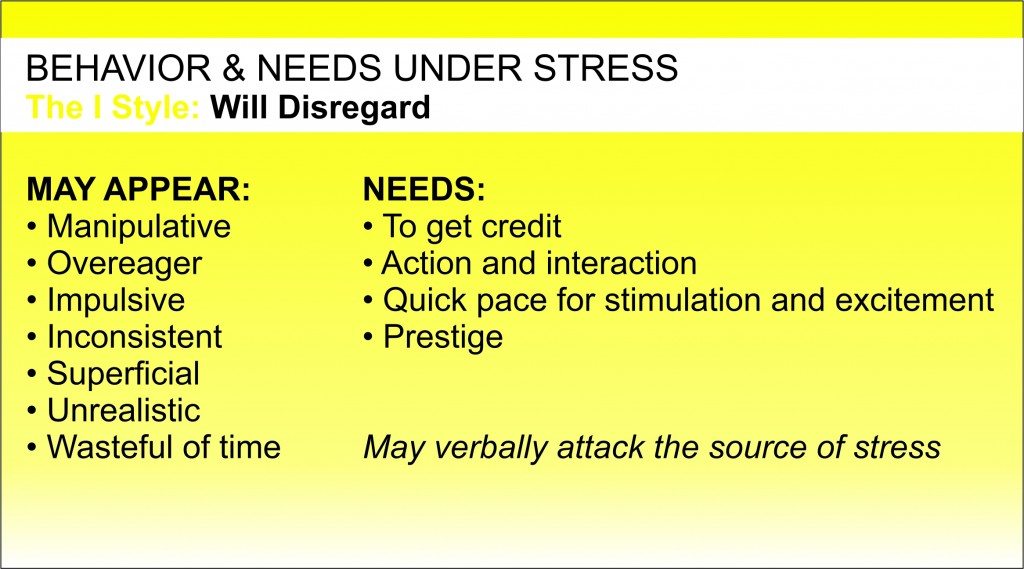
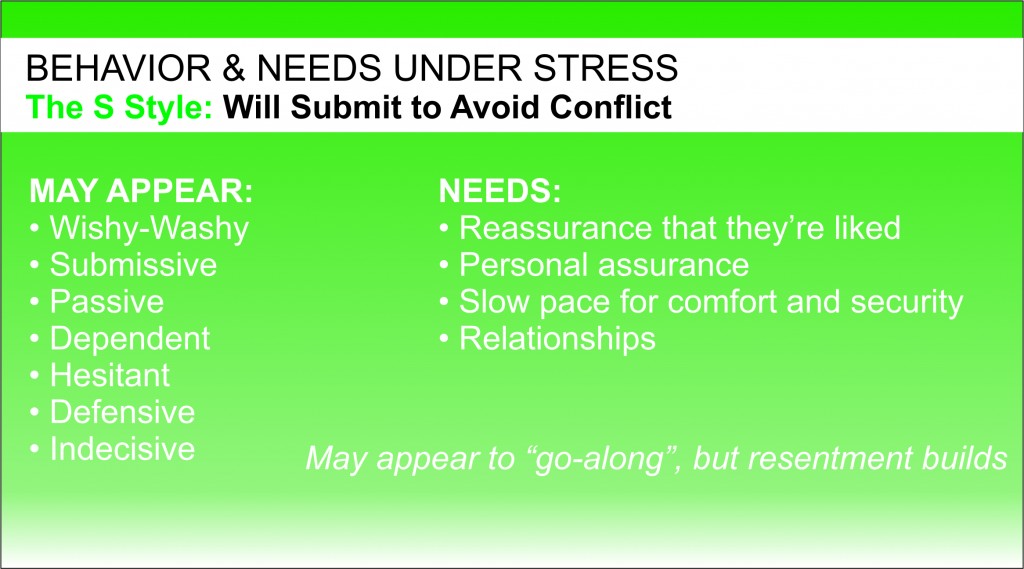
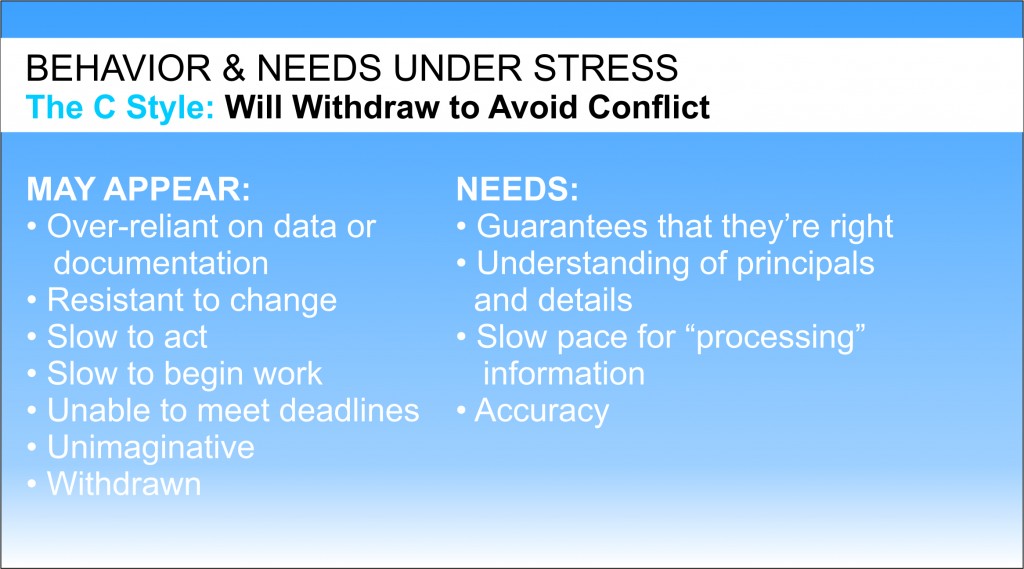
When we identify and control what is likely to stress us we can better react with thoughtfulness. (That is a good time to take a nice, deep breath.) It is OK to understand and accept that we are under stress and not in a comfortable place. That will start to refill our emotional bank account when we need it most. Here are comparisons for each style:
D Style
Emotional/Reactive: “If you can’t stand the heat, get out of the kitchen.”
Thoughtful: “I understand this is stressful. Let’s focus on what we CAN control.”
I Style
Emotional/Reactive: “Hey, let’s move on to something more positive!”
Thoughtful: “It’s difficult not seeing my friends. Can we find a time to get on a Zoom-social call?”
S Style
Emotional/Reactive: “Okay, if that’s the way you must have it, we’ll try it.”
Thoughtful: “I know things are uncertain right now. I just need to know that we are all in this together and we are going to get through it together.”
C Style
Emotional/Reactive: “I can’t help you any further. Do what you want.”
Thoughtful: “I know this is stressful. I just need to unplug for a day.”
When we can get our own emotions controlled by understanding and managing the things that we can affect, then we will be in a better position to help others. By communicating more effectively and reducing our reactive behavior, we will be in a better position to be more accommodating to those around us, on phone calls or in a video chat.
We can then remember to treat others the way they want to be treated. Don’t try to “fix” people. We can remember that they have different needs and fears and we can adapt ourselves to their pace or priority as best we can. It’s a time that we all need to listen more and pay attention to what other behavioral expressions we are broadcasting and being more accepting of the reactions of others.
So, in these troubling times, we do have the ability to make deposits to our own emotional bank account. Even better, when we pay attention and care for others, we can also make emotional deposits to the accounts of those people who are important to us.
Stay safe, stay well.
Tim
Send your questions about how to use your profile to identify and control what is likely to stress you sot that you can better react. Email
Call 772-210-4499 to set up a time to talk about tools and strategies that will lead to better results.
Please share this with a friend/colleague
More Tools:
The first step to building stronger communication is awareness. By identifying how we are similar and different, we can make cognitive choices when interacting to create stronger, more engaged relationships.
Deeper Look at Team Strength DISC Styles
The Upside of Stress Book Review
The Upside of Stress
By: Kelly McGonigal
Periodically, I share a favorite book review from Readitfor.me.
There is never enough time to read all the latest books – this tool is a great way to learn and to stay on top of the latest topics and new ideas.
The Readitfor.me tool has grown into a great resource for both personal and team growth, offering book summaries, micro courses and master classes. Check out this link: Readitfor.me. See how these tools can help build you personal and Team Strength.
Here is a summary of the Book
The Upside of Stress
by Kelly McGonigal
Book Review by Readitfor.me
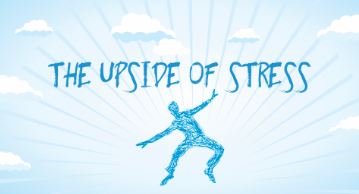
As it turns out, whether or not stress is harmful has a lot to do with how you view it.
Read on to learn how to change your mindset about stress.
Stress is bad for you, right?
As Kelly McGonigal tells us in this fascinating book, the research that scientists have done on stress tell a slightly different story.
As it turns out, whether or not stress is harmful has a lot to do with how you view it.
Consider the following research findings comparing people who view stress as harmful to people who view stress an enhancing.
People who believe stress is enhancing are less depressed and more satisfied with their lives than people who view stress as harmful. They have more energy and less health issues. They are more productive at work and are happier doing it. They also have a greater confidence in their ability to cope with challenges, and even find meaning in difficult circumstances.
That’s a pretty long list of benefits just for changing your mind about what stress means to you.
Join us for the next 12 minutes as we explore what stress actually is, and how you can completely change your relationship with it.
You might even learn how to harness the stress in your life to create a more meaningful, fulfilling life.
Let’s get started.
What is stress?
We first need to start with an understanding of what stress actually is. When you are feeling stress, your body releases cortisol and adrenaline.
From an evolutionary perspective, this stress response is designed to help you. But – like stress in general – it is more feared than appreciated. We’ve come to associate stress as toxic a state which we should try to minimize as much as possible.
But, as we’ll describe as we work our way through this book, your stress response is a resource to rely on rather than an enemy to eliminate.
How stress got a bad name
We won’t spend much time on this section. Basically, a scientist by the name of Hans Selye did a lot of stress research in the 1930s and 40s that showed that stress caused negative physical reactions.
He became known as the Grandfather of Stress, and was nominated for the Nobel Prize ten times, and devoted his life to spreading the word about his research, leading us all to believe that stress is toxic.
The problem is that all of his research was performed on rats, and in situations that bear little resemblance to everyday human stress.
This is what a typical day looked like for one of Selye’s lab rats. You’d start off with unpredictable, uncontrollable shocks. Then you’d get thrown in a bucket of water and forced to swim until you started to drown. Then, finally, you’d get put into an overcrowded cage with other rats where you would fight over an inadequate supply of food.
That, McGonigal rightly points out, isn’t stress – that’s the Hunger Games for rodents.
Nonetheless, Selye made the leap from rats to humans, and from torture to every day stress, and voila – we all developed a negative view about stress.
So now you have a negative mindset about stress
In recent surveys, the American Psychological Association has found that most people in America perceive their personal levels of stress as unhealthy.
These people believe that experiencing stress:
- depletes their health and vitality
- debilitates their performance and productivity
- inhibits their learning and growth
- is negative and should be avoided.
People who have this mindset about stress are much more likely to say that they cope with stress by trying to avoid it. They are more likely to:
- Try to distract themselves from the cause of the stress instead of dealing with it.
- Focus on getting rid of their feelings of stress instead of taking steps to address its source.
- Turn to alcohol or other substances or addiction to escape the stress.
- Withdraw their energy and attention from whatever relationship, role or goal is causing the stress.
Obviously, this reinforces the belief that stress is bad and should be avoided at all costs.
But as we turn our attention towards the benefits of embracing stress, we’ll find a much different story emerges.
Changing from a negative mindset to a positive one
As it turns out, you have a choice about how you respond to stress. Victor Frankl described this as the space between stimulus and response.
A minority of people in the general population believe that stress enhances their lives. These people believe that experiencing stress:
- enhances their performance and productivity
- improves their health and vitality
- facilitates their learning and growth
- is positive and should be utilized.
Where people with a negative mindset towards stress try to cope with stress, people with a positive mindset towards stress try to use it to their advantage. They are much more likely to:
- Accept the fact that the stressful event has occurred and is real.
- Plan a strategy for dealing with the source of stress.
- Seek information, help, or advice.
- Take steps to overcome, remove, or change the source of stress.
- Try to make the best of the situation by viewing it in a more positive way or by using it as an opportunity to grow.
So, just by creating a positive mindset about stress, you can turn self-doubt into confidence, fear into courage, and isolation into connection.
All without getting rid of the stress.
Which begs the question, how do you change your mind about stress?
The insight from the research is that you get what you expect. If you expect stress to be a negative experience, that’s exactly what you will get. If you expect it to be a positive experience, that’s exactly what you’ll get.
There is evidence for this in a lot of different areas of your life. For instance, how you think about getting older has some serious consequences for you later in life. People who have a positive view of aging add an average of 8 years to their life, and have an 80% lower risk of a heart attack.
Your mindset not only helps you in the moment, but also influences you to make better decisions in the future, leading to better outcomes. It’s as though mindset matters twice.
Now let’s turn our attention to the three different ways that your new positive mindset about stress will help you lead a more productive and fulfilling life.
Stress helps you engage
In this section we’ll focus on how you can transform a threat into a challenge.
Our common reaction to stress is to avoid it, and the most common advice you get when do deal with stress in the moment is to “calm down.” Basically, you should find a way to get rid of the stress.
However, viewing the stress response as a resource can transform the physiology of fear into the biology of courage. The stress response does a number of things that will help you perform well under pressure.
It focuses your attention, heightens your senses, increases your motivation, and mobilizes energy. This is true even when the stress doesn’t feel helpful, which is the case when people experience anxiety.
When you start to feel your heart pounding or your breath quickening, remember that this is your body’s way of trying to give you more energy. When you start to feel tension in your body, remember that the stress response gives you access to your strength. Are your palms sweaty? Good, that means you are close to something that you want. Do you have butterflies in your stomach? Embrace them – it’s your guts way of saying that this is something that matters.
If you take the traditional advice and try to calm down, you are preventing yourself from accessing the energy, strength and drive that the stress gives you. So, instead of trying to take a deep breathe to try and calm down, take a deep breath and sense the energy that’s available to you.
Then, use it. Ask yourself what action you can take that is consistent with your goal in this moment.
Connect: How tending and befriending transforms stress
In this section we’ll focus on how you can activate your “tend-and-befriend” response to better deal with stress.
From an evolutionary perspective, we have this “tend-and-befriend” response to make sure we protect our offspring. Rather than get paralyzed with fear (and let our offspring get eaten by that lion), we spring into action.
It does so because it increases activity in three systems in your brain.
First, it activates the social caregiving system, which is regulated by oxytocin. When this happens you feel more empathy, connection and trust.
Second, it activates the reward system, which releases the neurotransmitter dopamine. When this happens you feel more optimistic about your ability to do something meaningful, and it primes your brain for physical action, ensuring that you don’t freeze under pressure.
And third, it activates the attunement system, which releases to neurotransmitter serotonin. When this happens, your perception, intuition and self-control are all enhanced to ensure that the actions you take have the biggest positive impact.
In other words, as McGonigal points out, the tend-and-befriend response makes you social, brave and smart. Which is a much better response than trying to avoid dealing with whatever is causing you stress.
So, when you are feeling overwhelmed, look for opportunities to do something for somebody else that goes beyond your regular responsibilities.
Fair warning – your brain is going to tell you that you don’t have the time or energy to do it. But that’s exactly why you should. The good news is that small gestures work just as well as grand gestures to activate this response, so just get into action rather than waiting for the perfect moment to do something big.
Grow: how adversity makes you stronger
In this last section we’ll focus on how stress can actually help you learn and grow.
As McGonigal points out, the idea that we grow through adversity is not new. It’s embodied in the teachings of every major religion.
The science shows that plenty good can come from stressful or traumatic experiences. Here is a partial list of some of the positive changes that are commonly reported in cases of hardship, loss or trauma:
- A sense of personal strength;
- Increased appreciation for life;
- Spiritual growth;
- Enhanced social connections and relationships with others;
- Identifying new possibilities and life directions.
The important part, McGonigal explains, is that the good that comes from difficult experiences isn’t from the event itself – it comes from you.
What it requires is for you to look back on the difficult experiences from your past, and to reflect on the positive changes that came from them. Then, when you are faced with future stressful situations, you’ll be able to recall how you were able to overcome them in the past to help you overcome them in the moment.
This creates a growth-mindset towards adversity.
Conclusion
Ultimately, if you are trying to do big things in your life (the fact that you are reading this would suggest that’s the case), you are going to face adversity. Lots of it.
How you choose to deal with it is up to you. One path leads to growth and the fulfillment of your goals, and the other leads you despair and inaction.
And when you look at it that way, there really is only one choice.
If you are like my clients, you work hard learning how to grow your company or organization. You invest the time and money to improve your team for better results and increased value. The Readitfor.me tool has grown into a great resource for both personal and team growth, offering book summaries, micro courses and master classes. Check out this link for details Readitfor.me and see how this tool can you build your company for long term success.
Call 772-210-4499 or email to set up a time to talk about tools and strategies to lead to better results.
Please share this with a friend/colleague
 Tim is a Consultant to Business, Government and Not-for-Profits Organizations specializing in innovative and challenging ways for organizations to survive, to thrive and to build their teams.
Tim is a Consultant to Business, Government and Not-for-Profits Organizations specializing in innovative and challenging ways for organizations to survive, to thrive and to build their teams.